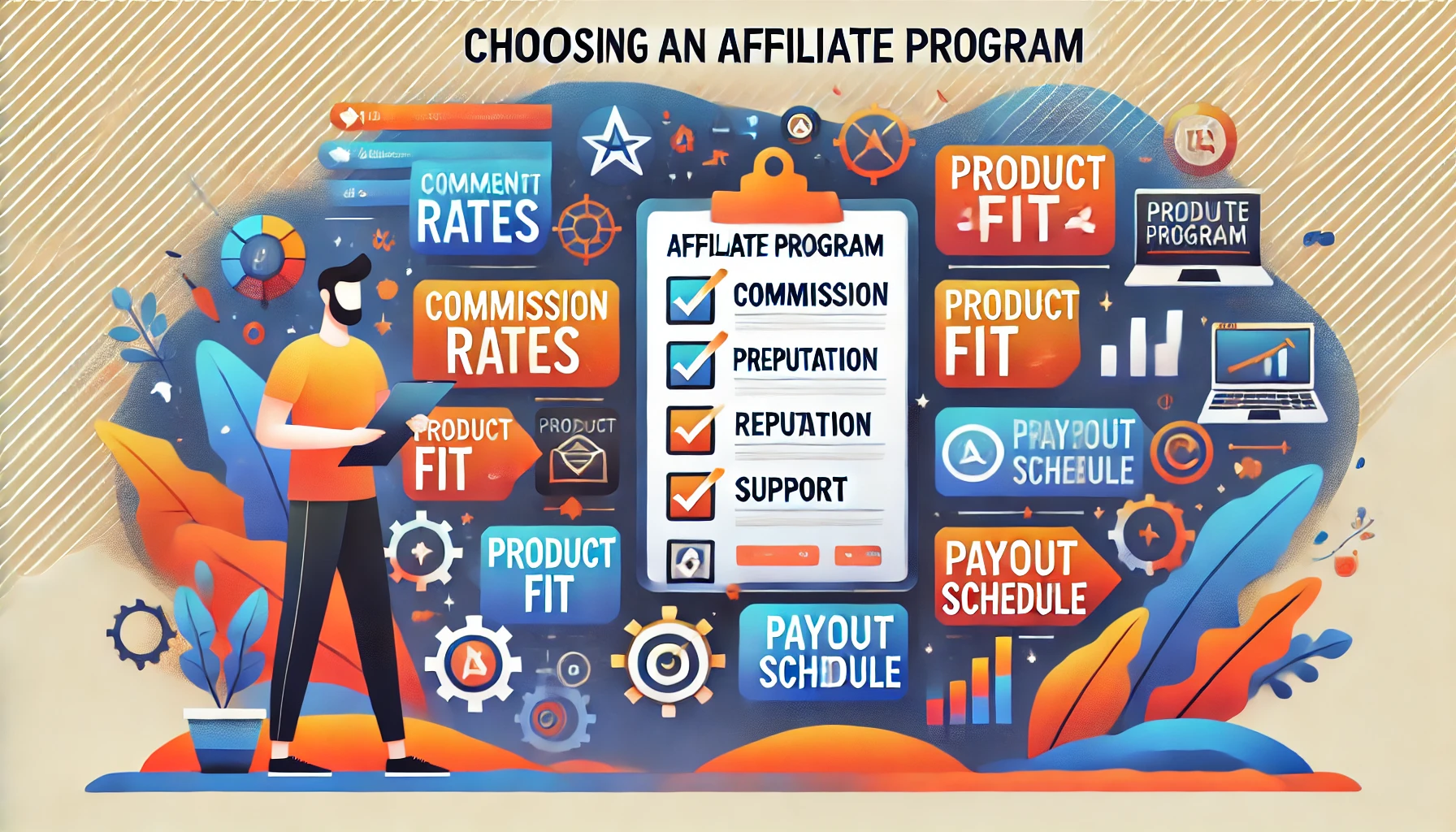How to Choose Your First Affiliate Program in 2024
Hey there! Ready to dive into this exciting world but not sure where to start? You’re not alone. Choosing your first affiliate program can be overwhelming with so many options out there. Did you know that the global affiliate marketing industry is expected to grow by 10% annually? But don’t worry, I’ve got your back! In this guide, I’ll walk you through everything you need to know to pick the perfect affiliate program for beginners. From understanding commission structures to evaluating product relevance, we’ll help you make an informed decision to choose your first affiliate program that sets you up for success. Let’s get started!
Understanding Affiliate Marketing Basics
Affiliate marketing might sound complicated, but it’s actually pretty simple. Here’s a breakdown:
- Definition of Affiliate Marketing: It’s a way to earn money by promoting other people’s products and earning a commission for each sale made through your unique link. More details about affiliate marketing in my previous article – What is Affiliate Marketing.
- How It Works: You sign up for an affiliate program, get a special link, and share it with your audience. When someone clicks your link and buys the product, you earn a commission.
- Key Terms You Need to Know:
- Commissions: The money you earn per sale.
- Cookies: Small files that track who clicked your link and if they made a purchase.
- Conversion Rates: The percentage of people who click your link and actually buy something.
Affiliate marketing is like being a middleman in sales. Imagine recommending a cool gadget to your friends. If they buy it through a link you share, you get a bit of money. Easy, right?
Identifying Your Niche
Choosing the right niche is crucial for your success in affiliate marketing. Here’s how to do it:
- Importance of Choosing a Niche: A niche helps you focus on a specific audience and makes it easier to create relevant content. It’s easier to become an expert in one area rather than trying to cover everything.
- Tips for Finding a Niche:
- Think about your interests and passions. What do you love talking about?
- Consider what you’re knowledgeable about. What topics do you know a lot about?
- Look for niches with high demand and low competition. This can make it easier to attract an audience.
- How to Assess Profitability:
- Check if people are spending money in this niche. Are there lots of products being sold?
- Use tools like Google Trends to see if interest in the niche is growing. This can help you understand if the niche is becoming more popular.
- Research if there are enough affiliate programs available. More programs mean more opportunities to earn.
Think of a niche as your special area. It could be anything from fitness to tech gadgets. The key is to find something you’re passionate about and that has a good audience.

Researching Affiliate Programs
Once you’ve chosen your niche, it’s time to find the right affiliate programs:
- Where to Find Affiliate Programs:
- Affiliate Networks: Platforms like Amazon Associates, ClickBank, and ShareASale are great places to start. They list many programs in one place.
- Individual Companies: Many companies run their own affiliate programs. Check their websites for details. For example, tech companies or fashion brands often have affiliate programs.
- Tools and Resources for Researching:
- Use websites like Affiliate Programs and Best Affiliate Programs for reviews and rankings. These sites can give you insights into the best programs available.
- Join affiliate marketing forums and communities for recommendations. Other marketers can provide valuable advice.
- Factors to Consider:
- Reputation of the program. Make sure the program is well-regarded and has good reviews.
- Quality of the products. Promoting high-quality products ensures your audience trusts you.
- Support and resources provided to affiliates. Good programs offer support to help you succeed.
Finding the right affiliate program is like choosing a partner. Look for reputable programs with good support and products you’re excited about.
Evaluating Commission Structures
Understanding how you’ll get paid is key. Here’s what to look for:
- Types of Commission Structures:
- Pay-Per-Sale: You earn a percentage of each sale. This is the most common type.
- Pay-Per-Click: You earn money every time someone clicks your link, even if they don’t buy. This can be easier to earn from but usually pays less.
- Pay-Per-Lead: You earn when someone takes an action, like signing up for a newsletter. This can be a good option if getting sales is tough.
- Average Commission Rates: Typically range from 5% to 50%, depending on the product and program. Higher rates are great, but lower rates on high-ticket items can also be lucrative.
- How to Calculate Potential Earnings: Multiply the commission rate by the average price of the products and estimate your monthly traffic and conversion rate. This gives you a rough idea of your earning potential.
Commission structures determine how much you’ll make. Higher commissions are great, but make sure they’re achievable with your audience.
Analyzing Product Relevance
Promoting the right products to your audience is crucial for success:
- Importance of Promoting Relevant Products: Your audience trusts you to recommend products that are genuinely useful to them. Irrelevant products can break that trust.
- How to Assess Relevance:
- Consider what products your audience would be interested in. What do they need or want?
- Ensure the products align with your niche. A fitness blog should promote workout gear, not kitchen appliances.
- Look at product reviews and ratings. High-rated products are more likely to satisfy your audience.
- Examples of Successful Product Promotion:
- If you’re in the fitness niche, promote workout gear, supplements, and fitness courses.
- For a tech niche, consider gadgets, software, and online courses.
Relevance is key. Promote products that fit your niche and that your audience will love. It makes them more likely to buy and trust your recommendations.
Checking Program Support and Resources
A good affiliate program supports its affiliates. Here’s what to look for:
- Importance of Program Support:
- Good customer service can help you solve issues quickly. This can save you a lot of headaches.
- Marketing materials like banners, email templates, and training can make your job easier. They provide ready-made tools to promote products effectively.
- Resources That Help You Succeed:
- Check if the program offers tutorials, webinars, and a dedicated affiliate manager. These resources can help you learn and grow.
- Examples of Programs with Excellent Support:
- Amazon Associates provides extensive resources and a large affiliate community. This makes it easier for beginners.
- ClickBank offers training materials and a supportive affiliate network. Their support can help you get started quickly.
Support is crucial, especially when you’re starting out. Good programs offer resources and help to ensure you succeed.
Reading Reviews and Testimonials
Learning from others’ experiences can help you make a better decision:
- How to Find Reviews and Testimonials:
- Look on websites like Trustpilot and G2. These sites gather reviews from users.
- Join affiliate marketing forums and ask for feedback. Other affiliates can share their experiences and advice.
- Red Flags to Watch Out For:
- Consistent complaints about payment issues. This could indicate problems with the program.
- Negative comments about product quality. Promoting low-quality products can hurt your reputation.
- Using Reviews to Make Informed Decisions:
- Compare different programs based on feedback. Look for patterns in the reviews.
- Look for programs with mostly positive reviews and a good track record. This suggests they’re reliable and trustworthy.
Reviews and testimonials are like report cards for affiliate programs. Use them to avoid bad programs and find good ones.
Considering the Program’s Terms and Conditions
Always read the fine print before joining a program:
- Importance of Understanding Terms and Conditions:
- Knowing the rules helps you avoid getting banned or losing commissions. It’s important to play by the rules.
- Key Terms to Look Out For:
- Payment schedules: How often you get paid. Monthly payouts are common.
- Cookie duration: How long the cookie stays active after someone clicks your link. Longer durations are better.
- Minimum payout: The minimum amount you need to earn before you get paid. Lower minimums are easier to reach for beginners.
- Examples of Fair and Transparent Program Terms:
- Programs that offer monthly payouts and have a clear cookie policy.
- Low minimum payout thresholds are easier for beginners.
Terms and conditions are like the rules of a game. Understand them to ensure you get paid and avoid issues.
Starting with a Trial Period
Test the affiliate programs before going all in. Testing a program before fully committing can save you time and effort:
- Benefits of Starting with a Trial Period:
- See if the program works well with your audience. This helps you avoid wasting time on bad programs.
- Test the support and resources provided. Make sure you’re happy with what’s offered.
- Setting Realistic Expectations:
- Don’t expect huge earnings right away. Focus on learning and adapting.
- Evaluating Your Performance:
- Track your clicks, conversions, and earnings. This helps you understand what works and what doesn’t.
- Adjust your strategy based on what you learn during the trial. This can improve your performance.
A trial period is like a test drive. Use it to see if the program is a good fit before fully committing.

Making Your Final Decision
After all the research, it’s time to choose the best program:
- Summarizing Key Factors:
- Product relevance, commission structure, support, and reviews.
- Weighing the Pros and Cons:
- List the positives and negatives of each program. This helps you make a clear decision.
- Steps to Take After Choosing:
- Sign up for the program. Follow the steps provided by the program.
- Start promoting the products. Use the resources and strategies you’ve learned.
- Monitor your performance and adjust your strategy as needed. Keep learning and improving.
Making your final decision is like picking a team. Choose the best fit and start working towards success.
By understanding the basics, identifying a profitable niche, and thoroughly researching your options, you can make a decision that sets you up for success. Remember, the right affiliate program should align with your interests, offer fair commissions, and provide ample support. Ready to take the plunge? Start researching today and embark on your exciting affiliate marketing adventure and choose your first affiliate program!



